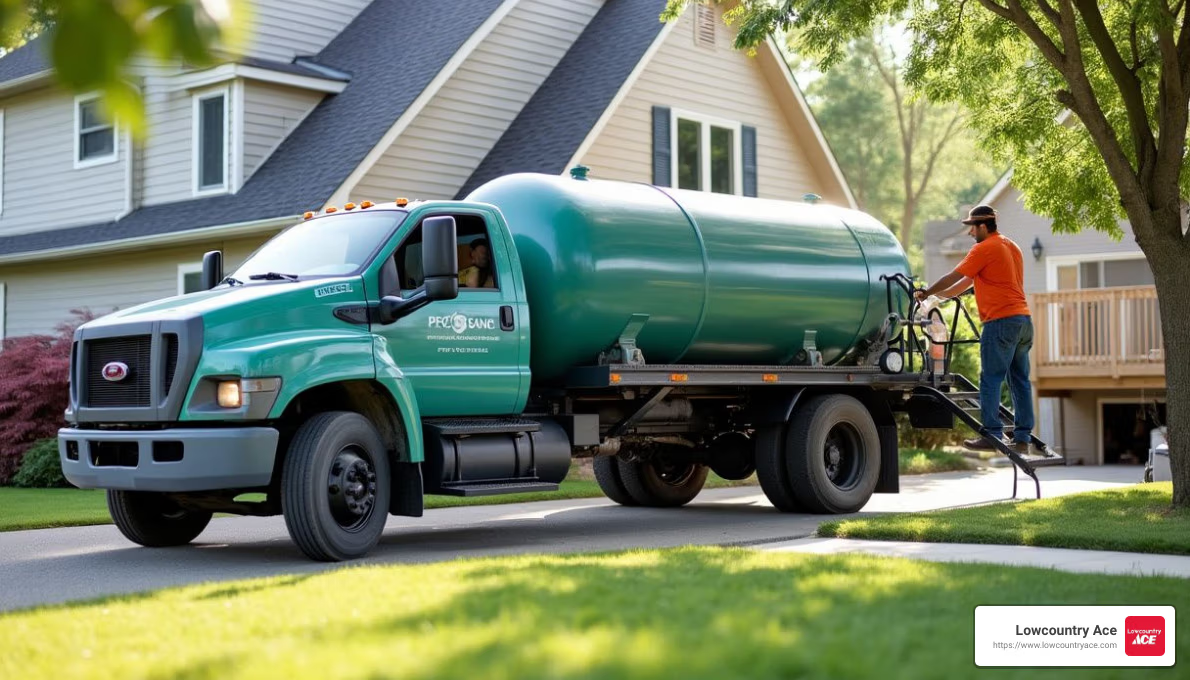Refilling Your Residential Propane Tank: What You Need to Know
When it comes to residential propane refill, ensuring safety and efficiency is paramount. Here’s what you need to know right away:
- Propane is highly flammable: Always handle with care and follow safety protocols.
- Refill or Exchange: Decide whether to refill your existing tank or exchange it for a filled one.
- Local Suppliers: Find reputable local suppliers to ensure quality and compliance.
Residential propane refill is essential for maintaining a consistent and safe fuel supply for your home. Whether you’re using propane for heating, cooking, or powering other appliances, regular refills ensure you never run out of this crucial energy source.
Safety first: Always prioritize safety when handling propane. Refilling your tank at authorized refill stations guarantees adherence to safety guidelines and reduces the risk of accidents.
I’m sure you have more questions about the process and how to stay safe. I’m here to help. I’m an expert in residential propane refills, and I’ve worked in the field to ensure homeowners get the information they need. Let’s dive deeper into everything you need to know about refilling your propane tank safely and efficiently.
Important residential propane refill terms:
Understanding Residential Propane Refill
Propane Tank Basics
Propane tanks come in various sizes, from small portable ones to large stationary tanks. The most common residential propane tank sizes range from 20-pound cylinders to 500-gallon tanks. These tanks are typically filled to 70-80% of their capacity to allow for gas expansion.
The Refill Process
Refilling your propane tank is a straightforward but precise process. Here’s a step-by-step guide:
- Check Tank Levels: Before refilling, ensure your tank is below 30% capacity.
- Transport Safely: Secure the tank upright during transport to prevent leaks.
- Authorized Refill Station: Take your tank to an authorized refill station. The helpful team at Lowcountry Ace can assist you with this.
- Inspection: The technician will inspect your tank for any damage or leaks.
- Refill: The technician will connect your tank to a large propane supply tank and fill it. They will monitor the fill level to ensure it doesn’t exceed 80% capacity.
- Leak Test: After refilling, a leak test is performed to ensure there are no leaks.
Safety Protocols
When dealing with propane, safety is paramount. Here are some key safety protocols to follow:
- No Smoking: Ensure there are no open flames or cigarettes nearby when handling propane.
- Ventilation: Always refill in a well-ventilated area to avoid gas accumulation.
- Protective Gear: Wear gloves and safety glasses to protect your hands and eyes.
- Check for Leaks: Use soapy water around the valve to check for leaks. Bubbles indicate a leak, and the tank should not be used.
Remember: Propane is highly flammable. Mishandling it can lead to dangerous situations. Always prioritize safety and follow these protocols.
How to Refill Your Propane Tank
Refilling your propane tank at home is simple if you follow the right steps and safety measures. Here’s how to do it safely and efficiently.
Step-by-Step Refill Guide
- Check Tank Levels: Ensure your tank is below 30% capacity before refilling.
- Transport Safely: Secure the tank upright in your vehicle to prevent leaks. Use ropes or straps to keep it steady.
- Visit an Authorized Refill Station: Bring your tank to a certified refill station. The helpful team at Lowcountry Ace can assist you.
- Inspection: The technician will inspect your tank for any damage or leaks before refilling.
- Connect and Refill: The technician will connect your tank to a large propane supply tank and fill it to 70-80% capacity to allow for gas expansion.
- Leak Test: After refilling, a leak test is performed using soapy water around the valve. Bubbles indicate a leak, and the tank should not be used.
Safety Measures
When handling propane, safety is crucial. Here are key safety tips:
- No Smoking: Ensure there are no open flames or cigarettes nearby when refilling.
- Ventilation: Refill in a well-ventilated area to avoid gas accumulation.
- Protective Gear: Wear gloves and safety glasses to protect your hands and eyes.
- Check for Leaks: Always inspect your propane bottle and the refill equipment for any signs of damage or leaks.
Remember: Propane is highly flammable. Mishandling it can lead to dangerous situations. Always prioritize safety.
Local Regulations
Local regulations may vary, so it’s important to be aware of them:
- Transport Rules: Some regions have specific rules for transporting propane tanks. Always keep the tank upright and secure.
- Certification: Ensure the refill station is certified and follows local safety standards.
- Storage: Store your tank outside in a shaded, well-ventilated area. Never store a propane tank indoors or in an enclosed space like a garage or basement.
Following these steps and safety measures ensures a smooth and safe residential propane refill experience.
Costs and Pricing
When it comes to residential propane refill, understanding the costs and pricing can help you make informed decisions. Here’s what you need to know:
Price Per Gallon
The cost of propane per gallon can vary. On James Island, for example, prices generally range from $3.50 to $4.25 per gallon. Always check for any additional taxes or fees that might apply. For instance, some local providers charge around $3.50 per gallon, while others may cost about $4.25 per gallon.
Factors Affecting Cost
Several factors can influence the price of propane:
- Seasonal Demand: Propane prices often rise in winter due to higher demand for heating.
- Location: Prices can vary by region. Rural areas might have higher costs due to transportation fees.
- Provider Rates: Different providers may have different pricing structures, including hidden fees like hazmat charges for safe handling and transportation.
Regional Differences
Propane costs can differ significantly based on where you live. For example, the national average price for propane is $2.337 per gallon. However, local factors such as supply chain logistics and regional demand can cause prices to fluctuate.
Saving Tips
To save money on propane refills:
- Compare Prices: Always compare prices at different refill stations.
- Avoid Hidden Fees: Be aware of any additional costs that may not be immediately obvious.
- Consider Refilling Over Exchanging: Refilling your tank is generally cheaper than exchanging it for a pre-filled one.
Understanding these factors can help you plan your propane refills more effectively and save money in the long run.
Next, we’ll explore how to find a propane refill location near you.
Finding a Propane Refill Location Near You
When it’s time for a residential propane refill, knowing where to go can save you time and hassle. Here’s how to find the best refill locations near you, whether you’re looking for local suppliers, refill stations, or delivery services.
Local Suppliers
Local suppliers are often the most convenient option for propane refills. They usually offer competitive prices and personalized service. For instance, Lowcountry Ace Hardware at 1411 Folly Road in the Riverland Market is a great local option. The helpful team at Lowcountry Ace ensures that customers receive top-notch service, making the propane refill process quick, easy, and safe.
Refill Stations
Refill stations are widely available and can be found at hardware stores, gas stations, and home improvement centers. Look for the AmeriGas sign or ask the helpful team at Lowcountry Ace for directions to the nearest refill facility. Refilling your propane cylinder is straightforward—just bring your empty tank to the station, and the staff will take care of the rest.
Benefits of Refill Stations:
- Convenience: Located in easily accessible places.
- Cost-Effective: Often cheaper than exchanging tanks.
- Quick Service: Get in and out quickly with your refilled tank.
Delivery Services
If you prefer the convenience of having propane delivered to your home, many suppliers offer delivery services. Companies like AmeriGas provide scheduled deliveries, ensuring you never run out of propane. This is especially useful for those with larger tanks or higher propane usage.
Advantages of Delivery Services:
- Convenience: No need to transport heavy tanks.
- Reliability: Scheduled deliveries ensure you always have propane.
- Safety: Professional handling reduces the risk of accidents.
How to Choose the Right Option
When choosing the best refill option for your needs, consider the following:
- Accessibility: Is the location close to your home or on your usual route?
- Price: Compare prices at different locations to get the best deal.
- Service Quality: Look for knowledgeable staff who can provide quick and efficient service.
For more information on finding a propane refill location near you, visit the Lowcountry Ace Hardware website or ask the helpful team at Lowcountry Ace.
Next, we’ll answer some frequently asked questions about residential propane refills.
Frequently Asked Questions about Residential Propane Refill
How much propane fills a 20 lb tank?
A 20 lb propane tank is a common size for residential use, especially for grills and small heaters. When filled to capacity, it holds about 4.7 gallons of propane. This is because propane tanks are typically filled to 80% of their total capacity to allow for expansion due to temperature changes.
Quick Facts:
- Tank Size: 20 lbs
- Propane Volume: ~4.7 gallons
- Fill Level: 80% capacity for safety
Do you have to exchange the same brand propane tank?
No, you generally don’t have to exchange the same brand propane tank. Most propane exchange services accept tanks from any brand as long as they meet safety standards and are in good condition. This flexibility makes it easier for you to keep your propane supply topped up without worrying about brand compatibility.
Key Points:
- Brand Compatibility: Most exchange services accept any brand.
- Condition: Ensure your tank is in good condition and meets safety standards.
- Convenience: Exchange services are designed to be hassle-free.
For more detailed information on propane refills or to find a refill location near you, visit the Lowcountry Ace Hardware website or ask the helpful team at Lowcountry Ace.
Conclusion
Refilling your residential propane tank is essential for maintaining a steady and efficient energy supply for your home. Whether you use propane for heating, cooking, or other applications, understanding the refill process and knowing where to find reliable services can make a big difference.
At Lowcountry Ace Hardware, we pride ourselves on providing top-notch customer service and convenience. Our team is dedicated to ensuring you have a seamless experience, from answering your questions to helping you find the best propane solutions for your needs.
Located at the Riverland Market on Folly Road, we serve the James Island and Folly Beach areas with a wide range of products and services. We offer home delivery, making it even easier to keep your propane tanks filled and your home running smoothly.
Why choose Lowcountry Ace for your propane needs?
- Local Expertise: We understand the unique needs of our community and are here to help.
- Quality Service: Our staff is trained to provide thorough inspections and ensure your tank is safe for refill.
- Convenience: With home delivery and a wide range of products, we make it easy for you to get what you need.
For more information on our propane refill services or to schedule a delivery, visit the Lowcountry Ace Hardware website. Our helpful team is always ready to assist you with your propane needs.
Thank you for choosing Lowcountry Ace Hardware. We look forward to serving you and ensuring you never run out of propane.
Lowcountry Ace Hardware: Your one-stop shop for home improvement. We offer quality products from trusted brands and expert advice from our experienced staff. Located on James Island, visit us for tools, hardware, fishing gear, power tools, building materials, grills & smokers, electrical and plumbing supplies, and more.






